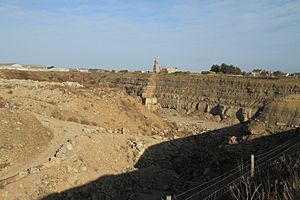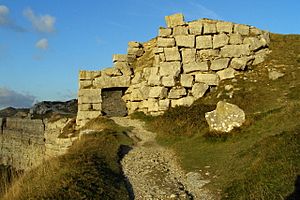Bowers Quarry facts for kids
Bowers Quarry/Mine is a busy stone quarry on the Isle of Portland, Dorset, England. It's on the west side of Portland, near the villages of Weston and Easton. Albion Stone runs the quarry. It became the first place on Portland where stone was dug out from underground, not just from the surface. In October 2002, they started this new way of getting stone. This led to the creation of Jordans Mine in 2008. Bowers Quarry is also the planned location for the Mass Extinction Memorial Observatory.
Contents
History of Bowers Quarry
Bowers Quarry has been active since the late 1700s. Back then, it was many small quarries run by different families. In 1979, Albion Stone took over the quarry's lease from the Crown Estate. The Crown Estate manages land owned by the King or Queen.
Over time, the quarry grew south towards the Weston area. Bowers became very deep. There was a lot of good stone near the edge that was hard to reach. This was because of a buffer zone and a thick layer of soil above the valuable Portland Stone.
From Quarrying to Mining
In 1998, Albion Stone got permission to try a new way of getting stone. They wanted to dig underground, which is called mining. This experiment aimed to reduce the impact of stone digging on the environment. The trial mining at Bowers began in 2002 and finished in 2005.
In 2006, they started digging out stone from the high walls of the quarry. Today, all stone from Bowers Quarry is taken out through underground mining. The main types of stone found here are Bowers Roach, Whitbed, and Basebed. In 2005, Albion Stone planned a new mine for Jordans Quarry, which also started successfully in 2008.
Future of the Quarry
In 2013, Dorset County Council approved a plan for Albion Stone to expand the mine. This means the mine now goes under the playing fields to the south. Albion Stone has a long-term lease for this land. New entrances have been dug into the quarry walls to reach this expanded area.
Experts believe these new areas have enough Portland stone to last for 20 to 30 years. As part of this plan, there's also an agreement to restore the entire quarry area step by step. This helps the land go back to a more natural state.
Mass Extinction Memorial Observatory
In 2006, a project called MEMO was started by Sebastian Brooke. MEMO stands for Mass Extinction Memorial Observatory. The goal is to build a special monument on the western cliffs at Bowers Quarry. This monument will honor all the animal and plant species that have disappeared from Earth.
The Crown Estate agreed to lease the land for MEMO. Weymouth and Portland Borough Council also gave the project the green light. As part of the project, almost half of Bowers Quarry will be turned back into limestone grassland. This helps nature recover.
The MEMO project is expected to cost between £20 million and £25 million. People are still raising money for it. Once it opens, visitors will pay an entry fee, which could be up to £9. It's hoped that about 140,000 people will visit each year within three years of it opening.
Harmonic Fields at Bowers Quarry
In August and September 2012, a unique art event took place at Bowers Quarry. It was called Harmonic Fields, created by Pierre Sauvegeot. This art piece had more than 500 musical instruments. These instruments were played by the wind!
The instruments were set up near the cliff edge in an unused part of Bowers Quarry. The natural energy of the wind created a beautiful, symphonic sound. Harmonic Fields was part of the London 2012 Festival. This festival was a 12-week celebration across the UK, bringing together artists from all over the world.



